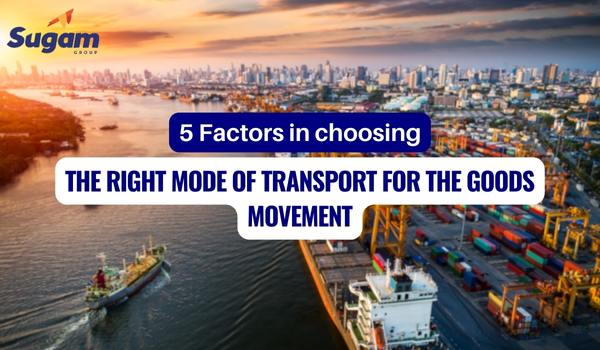5 Factors in choosing The Right Mode of Transport For The Goods Movement
Various types of goods require different type of transportation, and the choice of transportation depends on several factors:
- The nature of the company’s products, such as perishables, non-perishables, breakables, etc.
- Supplier production lead times.
- Product availability.
- The source of supply, indicating the pick-up destination, for example, China or other locations.
- Customs and Excise regulations, including duty, quarantine regulations, and others.
- Volume.
- The primary modes of transport include Railways, Roadways, Airways, Waterways, and Pipelines.
Each mode of transport has its own advantages and disadvantages based on factors like the type of consignment, budget considerations, and the required delivery speed. In certain situations, depending on client preferences, market demands, or geographical constraints, a combination of transportation modes may be necessary for successful goods delivery.
When choosing the most suitable mode of transport for transporting products from point A to B, various factors must be considered. The selection of the appropriate transportation mode is crucial for effective business and logistic management, contributing significantly to reducing shipping and logistics costs.
Export planning is a complex process. Depending on the destination, goods intended for foreign markets can be transported by road, rail, air, sea, inland waterways, or a combination of these. The key is to make the right selection and determine the most cost-effective combination of transport modes.
When deciding on the mode of transport to use, certain factors should be taken into consideration.
Factors Playing a Key Role in Selecting a Mode of Transport
Cost of Transport
The budget allocated for transportation is a critical factor in the mode selection process. Different modes have varying cost structures, and the choice depends on balancing cost considerations with the desired speed of delivery. Careful analysis of the overall transportation cost, including hidden expenses like insurance and finance charges, ensures financial viability.
You can check out Sugam Group Cost Calculator for Transportation/Logistic
Safety
Ensuring the safety and security of goods in transit is a paramount concern. The choice between land, air, or sea transport may be influenced by the track record of each mode in terms of security. Specialized requirements, such as the need for refrigeration or heightened security measures, impact the decision-making process.
Characteristics of Goods
The characteristics of the goods, including size, weight, fragility, and value, play a crucial role in determining the optimal transport mode. Fragile and high-value items may benefit from air transport, offering speed and careful handling. Heavier or bulkier goods might be better suited for sea or rail transport, considering the cost-effectiveness of these modes.
Budget
Transportation costs add to the product’s sale price, affecting profitability. Budget considerations must align with the volume or weight of goods, urgency of delivery, and the type of goods, especially perishable items. Water transport is cost-effective for bulky, non-urgent shipments, while rail transport is relatively inexpensive. Road transport offers savings on handling and packaging costs. Air transport is expensive but rapid, making it suitable for perishable and fragile goods.
Reliability and Regularity of Service
The reliability and regularity of service vary among different transport modes. The urgency and speed of delivery influence the choice of transport mode, with all modes susceptible to delays caused by adverse weather conditions such as heavy rains, snow, fog, and storms.
Conclusion:
Selecting the right mode of transport for goods movement is a critical decision that involves considering various factors to ensure efficiency, cost-effectiveness, and timely delivery. The nature of the goods, production lead times, availability, source of supply, customs regulations, and volume are key determinants in this decision-making process.
The transportation landscape offers multiple modes, including Railways, Roadways, Airways, Waterways, and Pipelines, each with its own set of advantages and disadvantages. The choice between these modes depends on the specific characteristics of the consignment, budget constraints, and the urgency of delivery. Often, a combination of transportation modes is necessary to meet client preferences, market demands, or geographical constraints.
Key factors such as the cost of transport, safety considerations, characteristics of goods, budget constraints, and the reliability of services play a pivotal role in the decision-making process. Importers and exporters need to carefully assess the overall transportation cost, including hidden costs, to ensure financial viability.
In the complex process of export planning, where goods may traverse road, rail, air, sea, inland waterways, or a combination, making the right selection is paramount. The goal is to determine the most cost-effective combination of transport modes, aligning with budgetary requirements and delivery urgencies.
Ultimately, the success of goods delivery hinges on the strategic selection of the transportation mode, demonstrating the importance of thorough consideration and planning in international logistics and trade.




No Comments